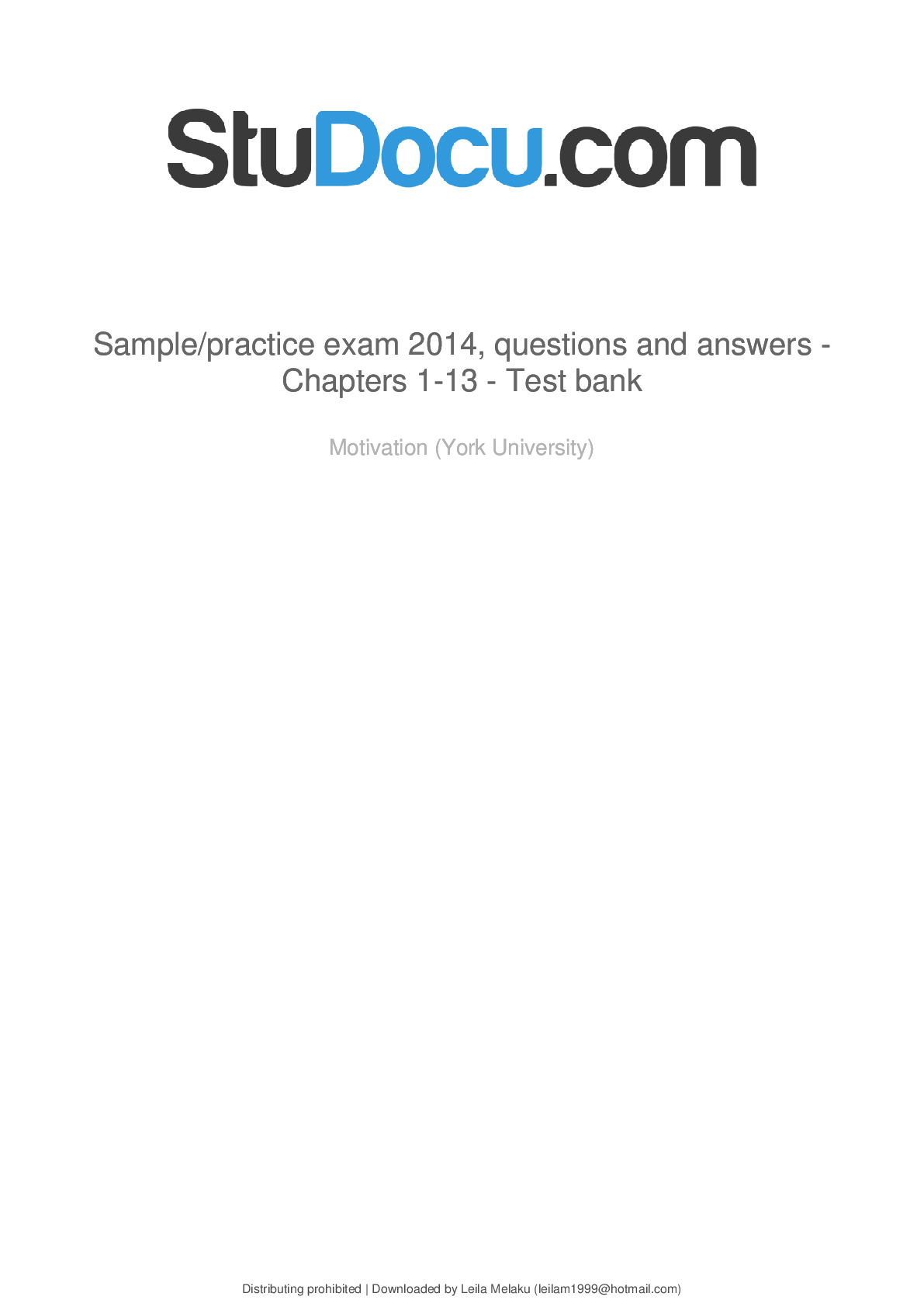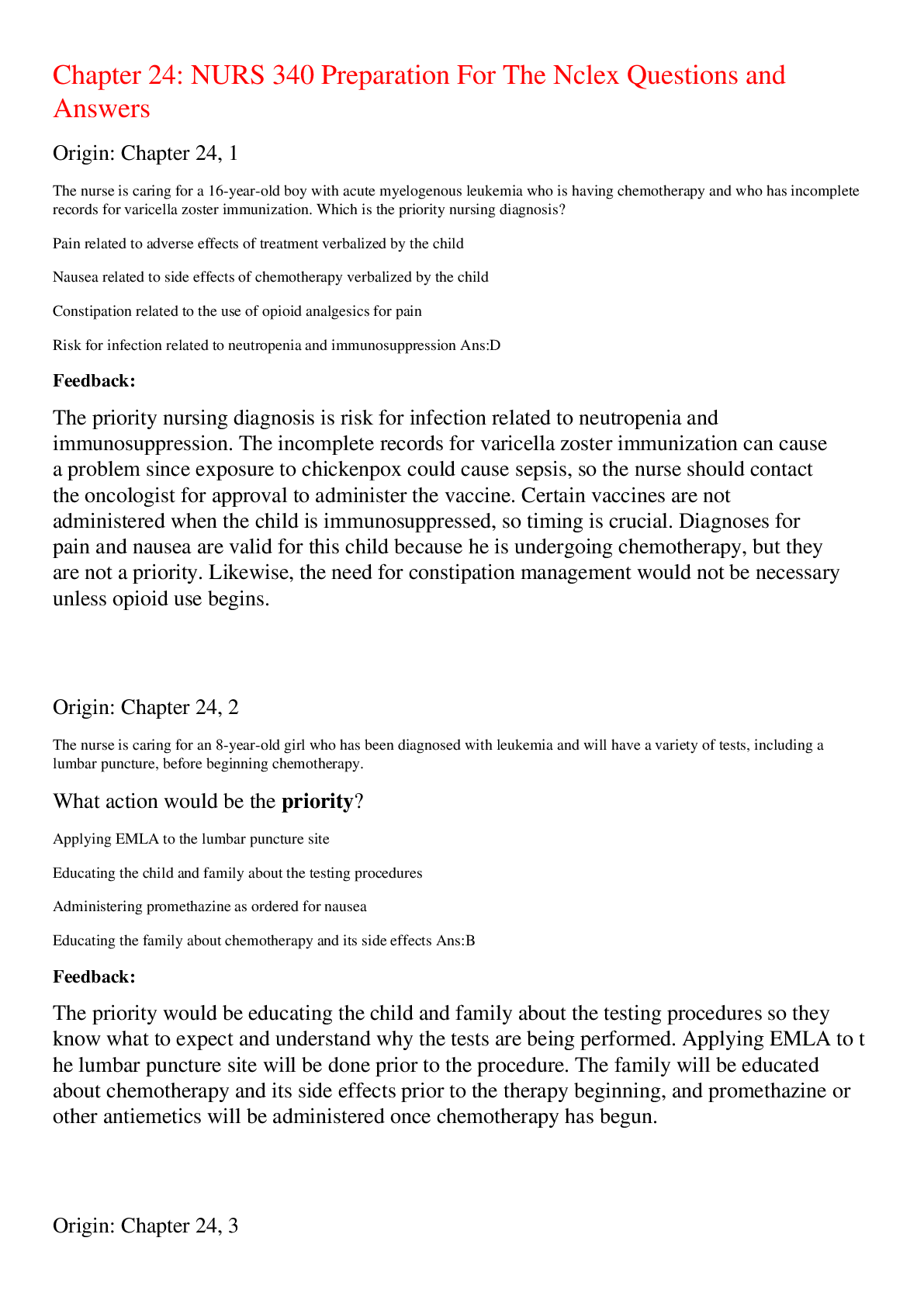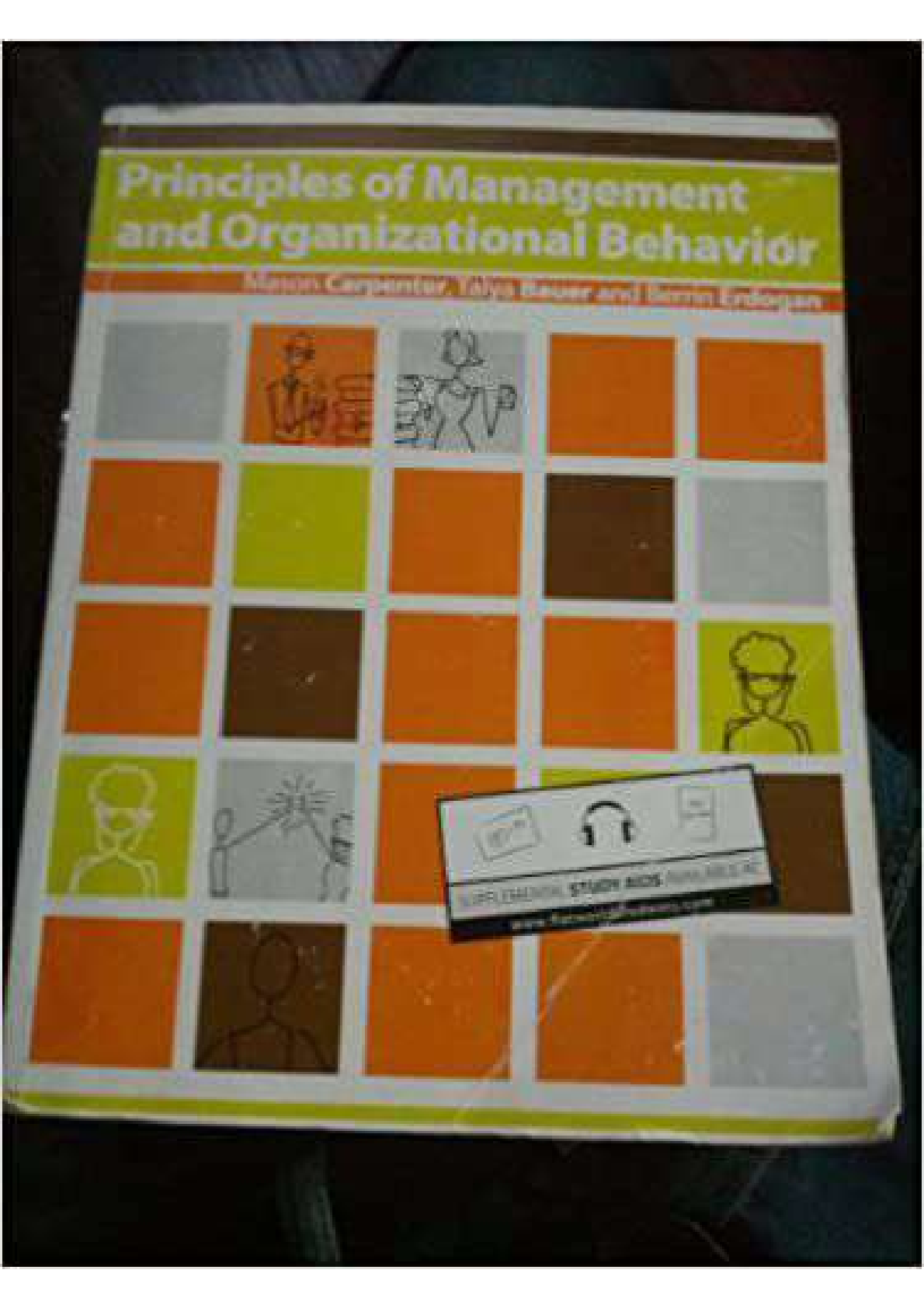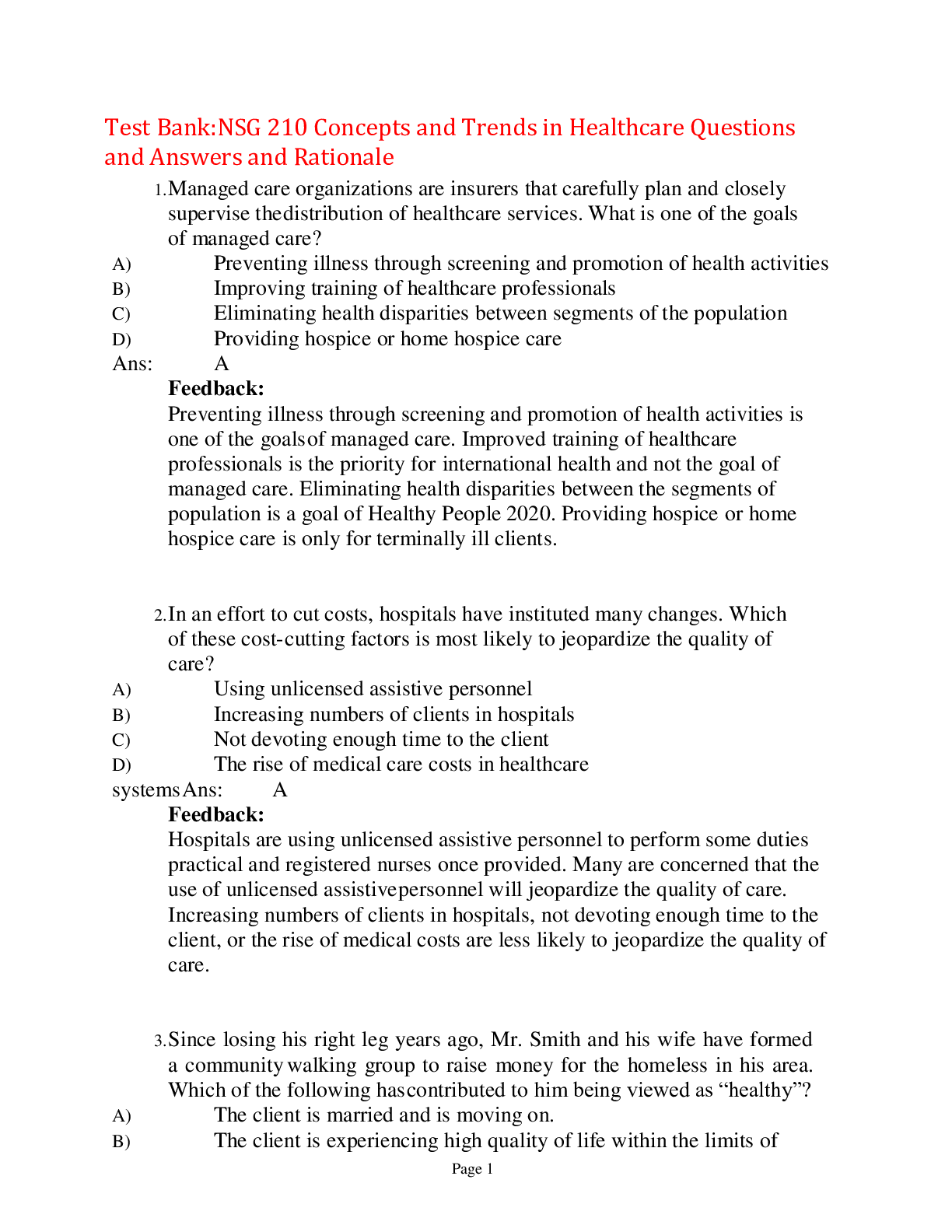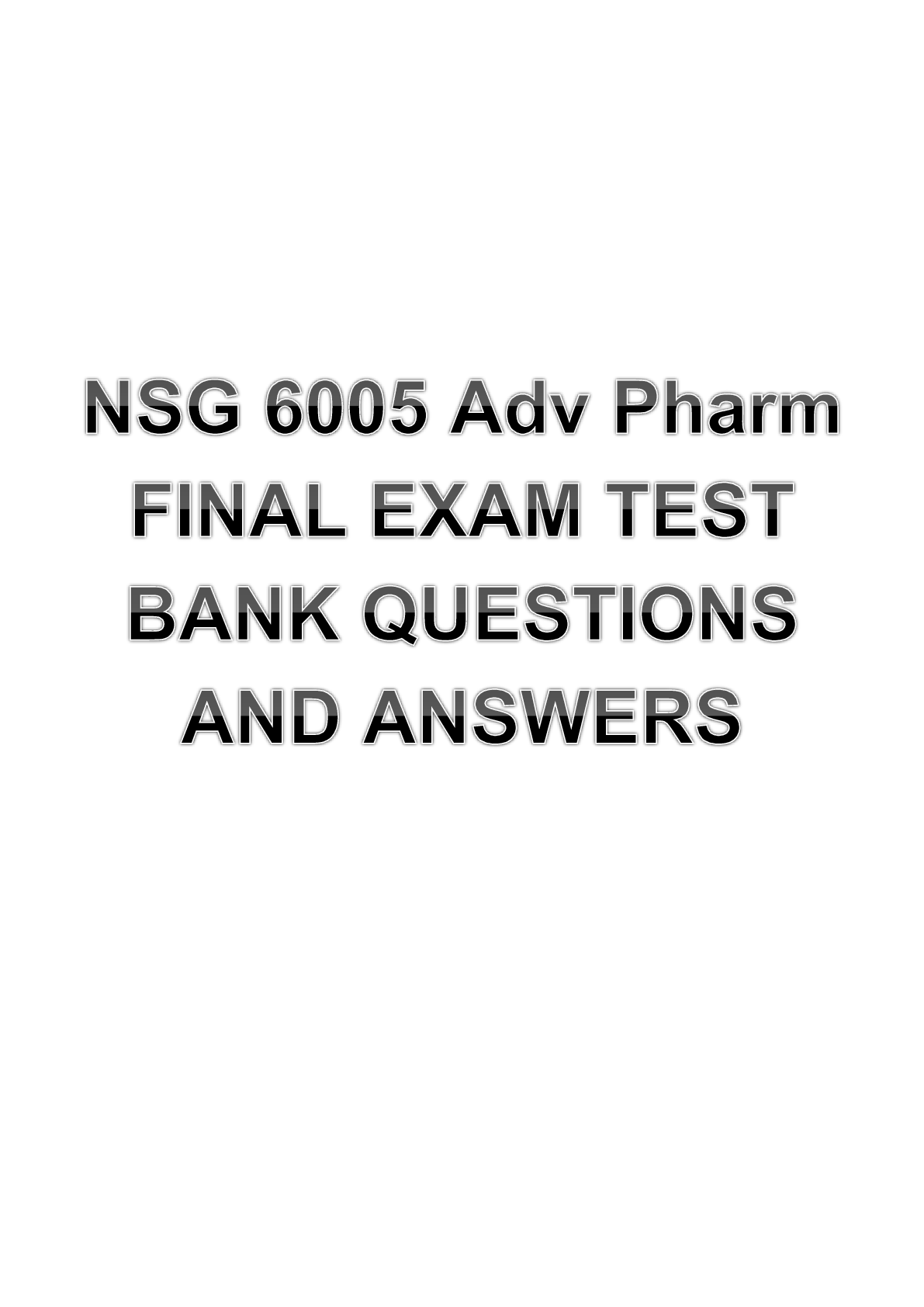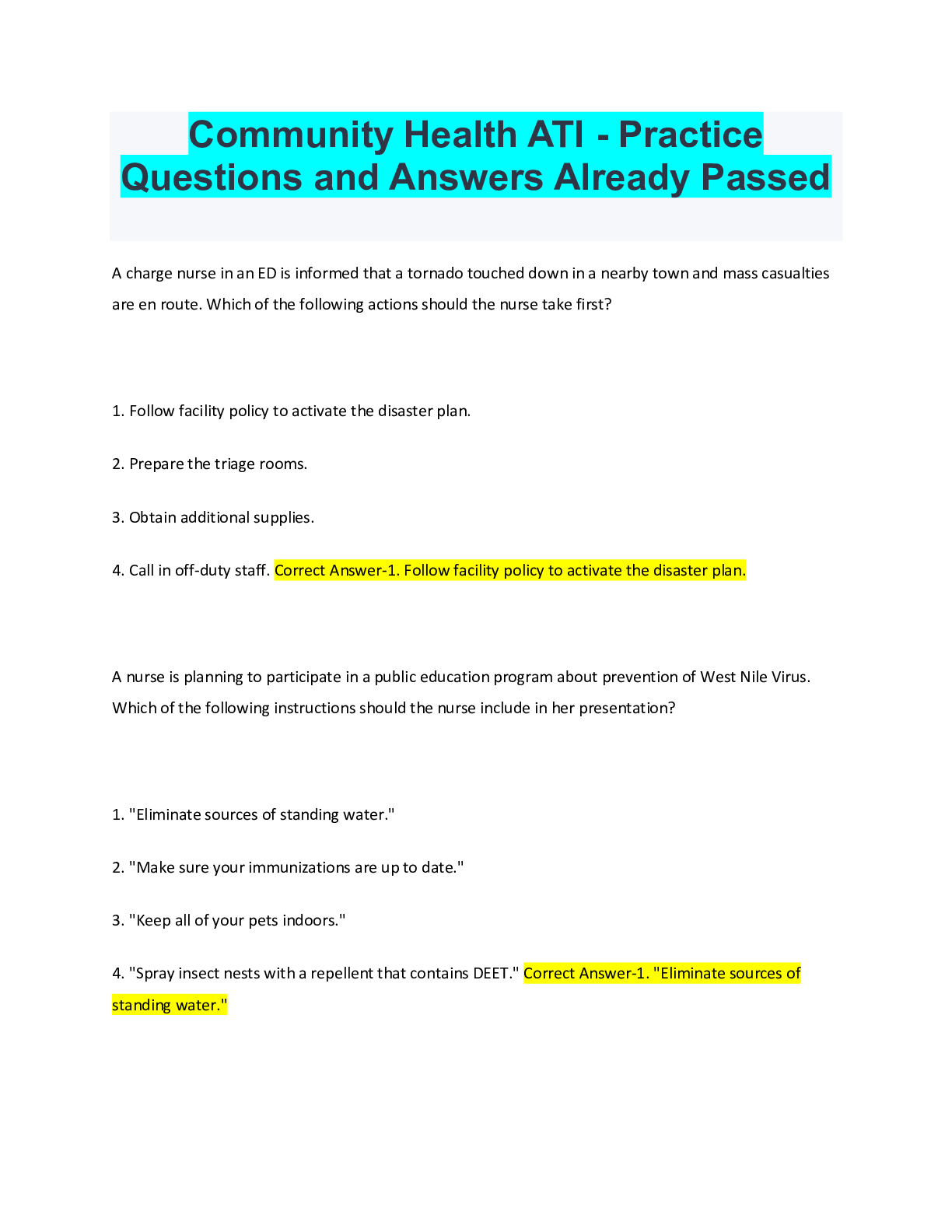Health Care > TEST BANK > ANATOMY 1011 CHAPTER 1-12 TESTS QUESTIONS AND ANSWERS 100% CORRECT (All)
ANATOMY 1011 CHAPTER 1-12 TESTS QUESTIONS AND ANSWERS 100% CORRECT
Document Content and Description Below
CHAPTER 1 Question 1 2.2 out of 2.2 points Which organ system produces immune cells and has a role in fluid balance? Selected Answer: Lymphatic system Answers: Integumentary system Circulato... ry system Endocrine system Lymphatic system Response Feedback: The lymphatic system produces immune cells and has a role in fluid balance. The integumentary system has a role in protection, temperature regulation, water retention, and sensation. The circulatory system distributes oxygen, nutrients, water, hormones, and other electrolytes; it also has a role in fluid and electrolyte balance. The endocrine system produces hormones and regulates other systems. Question 2 2.2 out of 2.2 points The type of plane that divides the body horizontally into upper and lower portions is called a Selected Answer: transverse plane. Answers: sagittal plane. frontal plane. transverse plane. coronal plane. Response Feedback: A transverse plane divides the body horizontally into upper and lower portions. A sagittal plane divides the body lengthwise into right and left sides. A frontal plane divides the body lengthwise into anterior and posterior positions. A coronal plane is another name for a frontal plane. Question 3 2.2 out of 2.2 points ANATOMY 1011 CHAPTER 1-12 TESTS QUESTIONS AND ANSWERS 100% CORRECT The heart is located in the mediastinum, which is part of what cavity? Selected Answer: Thoracic cavity Answers: Thoracic cavity Dorsal cavity Spinal cavity Cranial cavity Response Feedback: The mediastinum is part of the thoracic cavity. The dorsal cavity is located at the back of the body. The spinal and cranial cavities are part of the dorsal cavity. Question 4 2.2 out of 2.2 points Which of the following correctly describes the anatomical position? Selected Answer: Standing erect with arms at sides and with palms, face, and feet facing forward Answers: Standing erect, facing forward, with arms outstretched Standing erect with arms at sides, palms facing backward, face and feet facing forward Standing erect with arms overhead, face and feet facing forward Standing erect with arms at sides and with palms, face, and feet facing forward Response Feedback: The anatomical position involves standing erect with arms at the sides and with face, palms, and feet facing forward. Question 5 2.2 out of 2.2 points A patient comes to the hospital for treatment of pain in the right hypochondriac region. Based on the organs located in that region, which organ might be causing the pain? Selected Answer: Gallbladder Answers: Stomach Small intestines Gallbladder Appendix Response Feedback: The gallbladder is located in the right hypochondriac region. The stomach is found in the epigastric region. The small intestines are in the right and left lumbar regions, right and left iliac regions, and hypogastric region. The appendix is in the right iliac region. Question 6 2.2 out of 2.2 points Most illustrations that show the contents of the abdominal cavity use what type of plane? Selected Answer: Frontal Answers: Sagittal Transver se Horizont al Frontal Response Feedback: Most illustrations that show the contents of the abdominal cavity use a frontal plane. A sagittal plane is used to illustrate the organs of the head or pelvic cavity. A horizontal plane is another name for a transverse plane. A transverse plane is used by computed tomography scanners. Question 7 2.2 out of 2.2 points The structure of the body is called physiology; how it functions is called anatomy. Selected Answer: Fals e Answers: True Fals e Response Feedback: The structure of the body is called anatomy; how it functions is called physiology. Question 8 2.2 out of 2.2 points The human body is organized from the very simple to the very complex. Selected Answer: Tru e Answers: Tru e False Question 9 2.2 out of 2.2 points The dorsal cavity contains the Selected Answer: cranial and spinal cavities. Answers: thoracic and abdominopelvic cavities. cranial and spinal cavities. mediastinum and pleural cavities. abdominal and pelvic cavities. Response Feedback: The dorsal cavity contains the cranial and spinal cavities. The other cavities are all contained in the ventral cavity. Question 10 29.4 out of 29.4 points Match each term to its location on the body. Question Correct Match Selected Match Arm C. brachial C. brachial Lower back K. lumbar K. lumbar Armpit P. axillary P. axillary Heel L. calcaneal L. calcaneal Fingers G. digital G. digital Shoulder B. deltoid B. deltoid Sole of the foot M. plantar M. plantar Forehead A. frontal A. frontal Chest E. pectoral E. pectoral Front of elbow H. antecubita l H. antecubital Foot N. pedal N. pedal Cheek I. buccal I. buccal Groin D. inguinal D. inguinal Ankle O. tarsal O. tarsal Question 11 2.2 out of 2.2 points The two major body cavities are the dorsal and ventral cavities. Selected Answer: Tru e Answers: Tru e False Question 12 2.2 out of 2.2 points Negative feedback is when an effector opposes the stimulus and reverses the direction of change. Selected Answer: Tru e Answers: Tru e False Question 13 2.2 out of 2.2 points Which organ system protects organs, allows for support and movement, and also plays a key role in blood formation? Selected Answer: Skeletal system Answers: Circulatory system Muscular system Skeletal system Nervous system Response Feedback: The skeletal system protects organs, gives the body support and allows it to move, and also plays a role in the formation of blood cells. The circulatory system distributes oxygen, nutrients, water, hormones, and other electrolytes; it also has a role in fluid and electrolyte balance. The muscular system allows the body to move and produces heat. The nervous system regulates and coordinates other systems, and also has a role in sensation and memory. Question 14 16.6 out of 16.6 points Match each term to its definition. Question Correct Match Selected Match Toward the back of the body H. posterior H. posterior Farthest from the point of origin A. distal A. distal Above E. superior E. superior At or near the body’s surface I. superficial I. superficial Toward the body’s midline C. medial C. medial Closest to the point of origin B. proximal B. proximal Toward the front of the body G. anterior G. anterior Below F. inferior F. inferior Question 15 21 out of 21 points Match the name of each organ system to its key components. Question Correct Match Selected Match Consists of stomach, small and large intestines, liver, and pancreas J. digestive system J. digestive system Consists of skin, hair, and nails A. integumentary system A. integumentary system Consists of kidneys, ureters, urinary bladder, and urethra F. urinary system F. urinary system Consists primarily of skeletal muscles C. muscular system C. muscular system Consists of heart, arteries, veins, and capillaries I. circulatory system I. circulatory system Consists of brain, spinal cord, nerves, and sense organs G. nervous system G. nervous system Consists of ovaries, fallopian tubes, uterus, vagina, and breasts L. female reproductive system L. female reproductive system Consists of pituitary gland, adrenals, pancreas, and thyroid H. endocrine system H. endocrine system Consists of lymph nodes, lymphatic vessels, lymph, thymus, and spleen D. lymphatic system D. lymphatic system Consists of the nose, pharynx, larynx, trachea, bronchi, and lungs E. respiratory system E. respiratory system Question 16 2.2 out of 2.2 points Bone, cartilage, and adipose tissue are all types of Selected Answer: connective tissue. Answers: epithelial tissue. connective tissue. muscle. nerve tissue. Response Feedback: Bone, cartilage, and adipose tissue are all types of connective tissue. Question 17 2.2 out of 2.2 points Which type of tissue covers the body’s surface? Selected Answer: Epithelia l Answers: Epithelia l Connecti ve Muscle Nerve Response Feedback: Epithelial tissue covers the body surfaces. Connective tissue connects and supports parts of the body. Muscle contracts to produce movement. Nerve tissue generates and transmits impulses to regulate body function. Question 18 2.2 out of 2.2 points The constancy of the body’s internal environment is called homeostasis. Selected Answer: Tru e Answers: Tru e False CHAPTER 2 Question 1 2.3 out of 2.3 points Which four elements make up more than 96% of the human body? Selected Answer: Oxygen, carbon, hydrogen, and nitrogen Answers: Oxygen, carbon, hydrogen, and iron Carbon, hydrogen, calcium, and oxygen Nitrogen, oxygen, carbon, and sodium Oxygen, carbon, hydrogen, and nitrogen Response Feedback: Oxygen, carbon, hydrogen, and nitrogen are the most abundant elements in the human body and account for 96% of its mass. Calcium, iron, and sodium are critically important to the body’s structure and function but combined they make up less than 2% of its mass. Question 2 2.3 out of 2.3 points How do cells obtain energy? Selected Answer: Cells break bonds in ATP molecules. Answers: Energy is made in the liver and released into the blood for the cells to use. Cells break down protein molecules. Energy stored as fat is released into the blood. Cells break bonds in ATP molecules. Response Feedback: Cells obtain energy by breaking phosphate bonds in the ATP molecule. The liver does not release energy into the bloodstream; cells release energy when they need it. Proteins, fats, and carbohydrates can all be used for energy production; however, those substances must first be converted to ATP. Question 3 2.3 out of 2.3 points Covalent bonds form when Selected Answer: two atoms share electrons to fill their outer shells. Answers: positively charged hydrogen atoms attract negatively charged atoms. electrostatic forces bring atoms together to form a new molecule. two atoms share electrons to fill their outer shells. a nitrogen atom combines with a carbon atom. Response Feedback: Covalent bonding occurs when electrons are shared by two atoms so that each has a complete outer shell of eight electrons. The attraction of hydrogen atoms to oxygen atoms is an example of hydrogen bonding. Electrostatic forces pull ions together; no electrons are shared. Nitrogen and carbon are involved in peptide bonds. Question 4 2.3 out of 2.3 points Where are protons and neutrons located? Selected Answer: Protons and neutrons both reside in the nucleus. Answers: Protons and neutrons orbit the nucleus in one or more concentric clouds. Protons orbit the nucleus in a cloud, and neutrons reside in the nucleus. Protons and neutrons both reside in the nucleus [Show More]
Last updated: 1 year ago
Preview 1 out of 155 pages
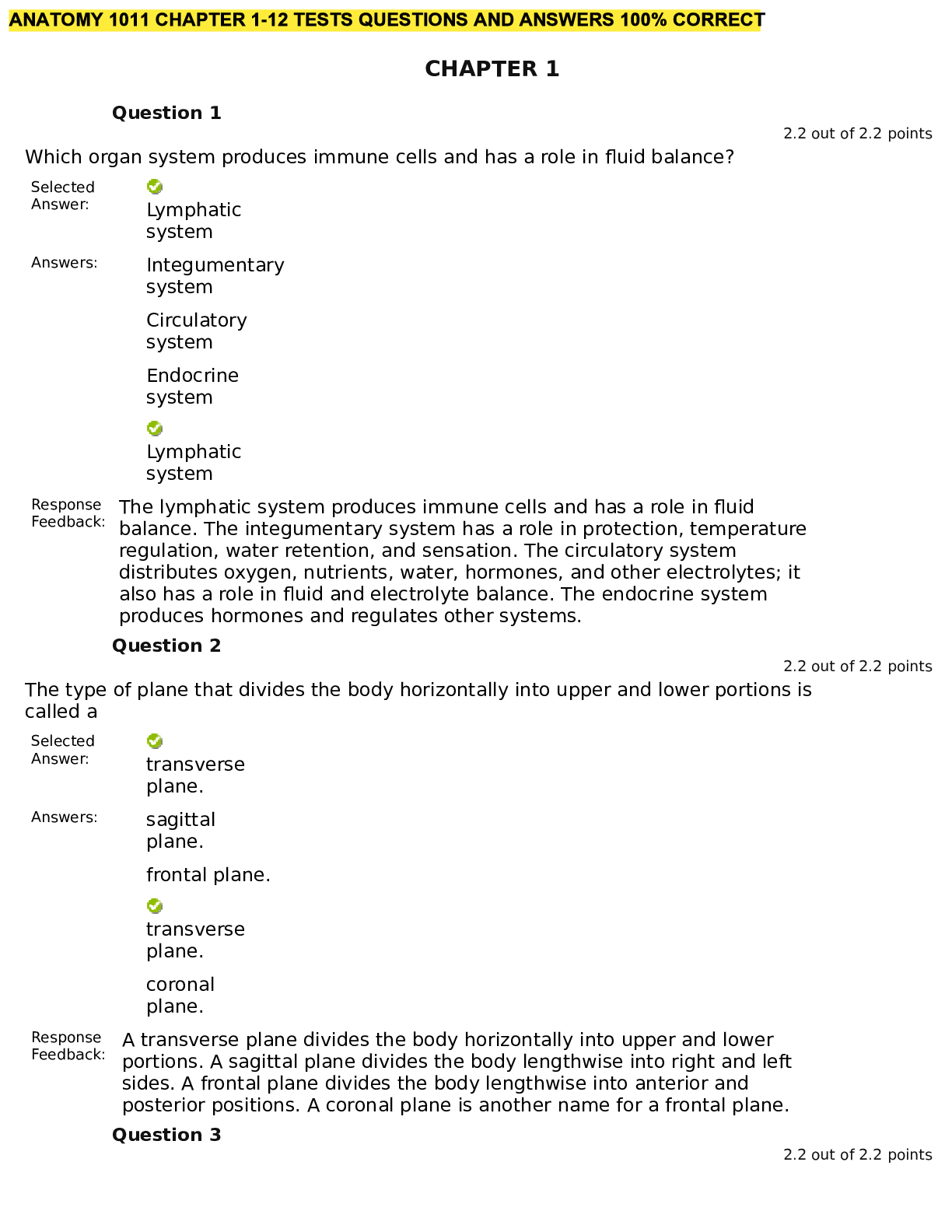
Reviews( 0 )
Document information
Connected school, study & course
About the document
Uploaded On
Sep 07, 2022
Number of pages
155
Written in
Additional information
This document has been written for:
Uploaded
Sep 07, 2022
Downloads
0
Views
33


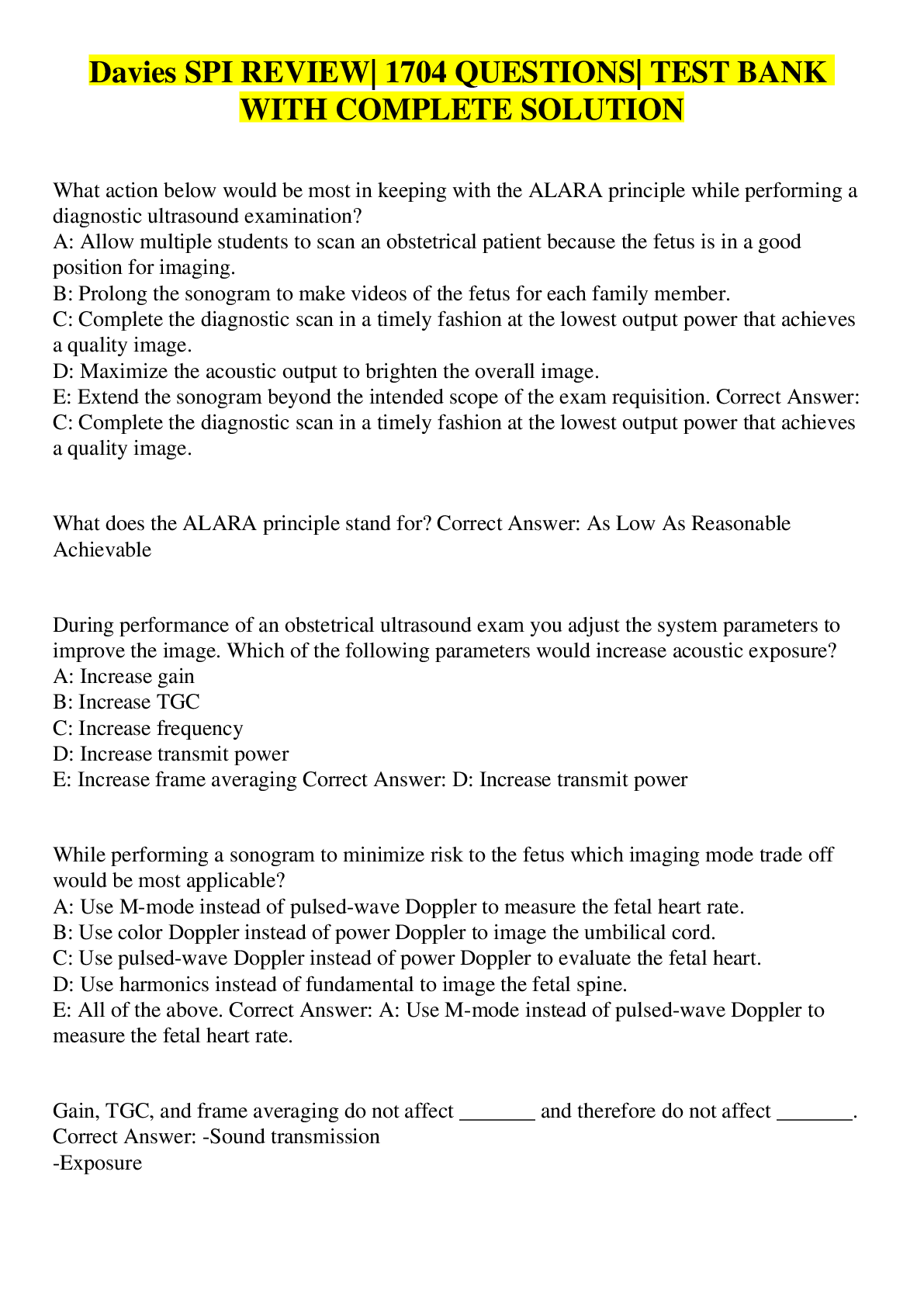
.png)

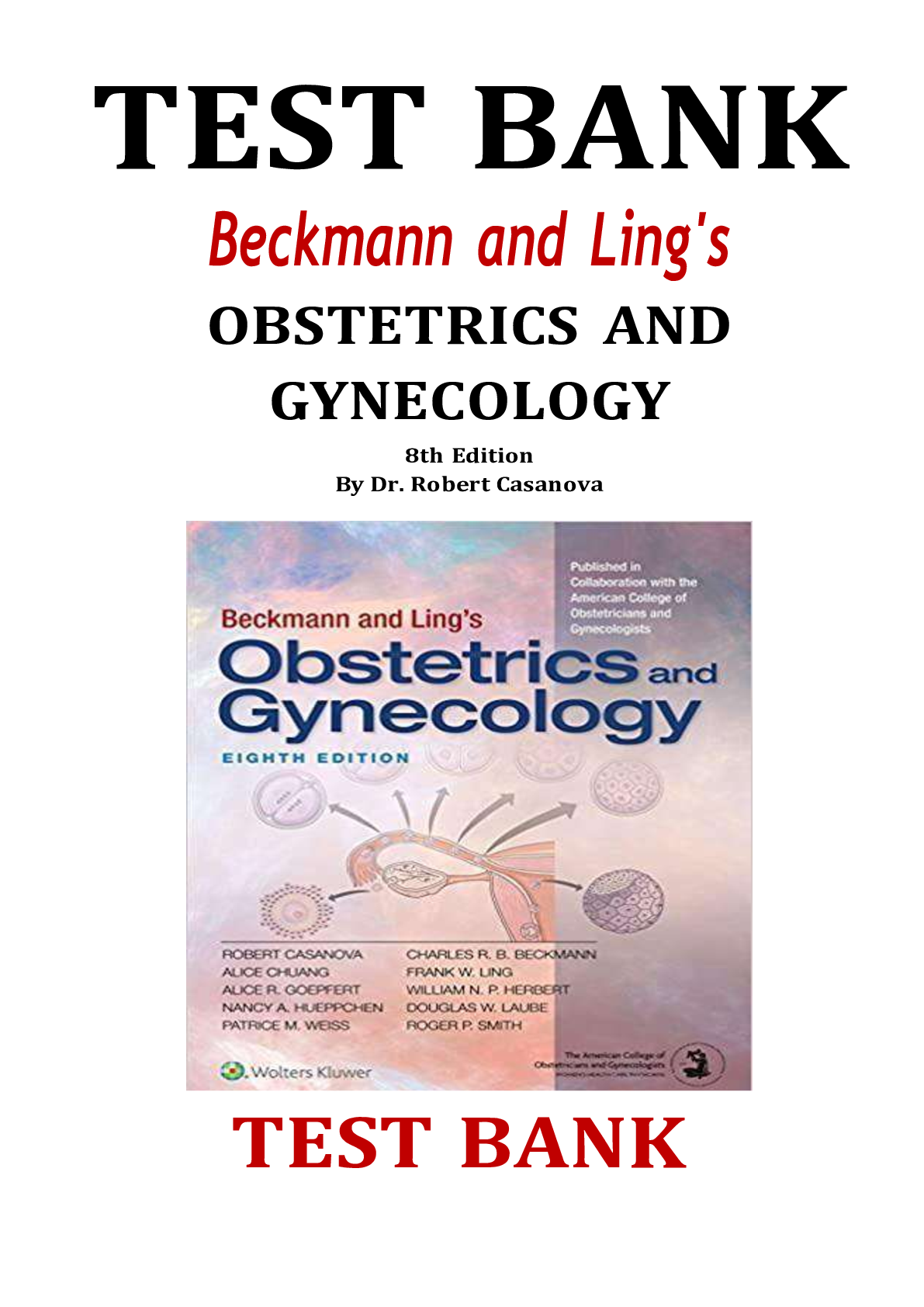


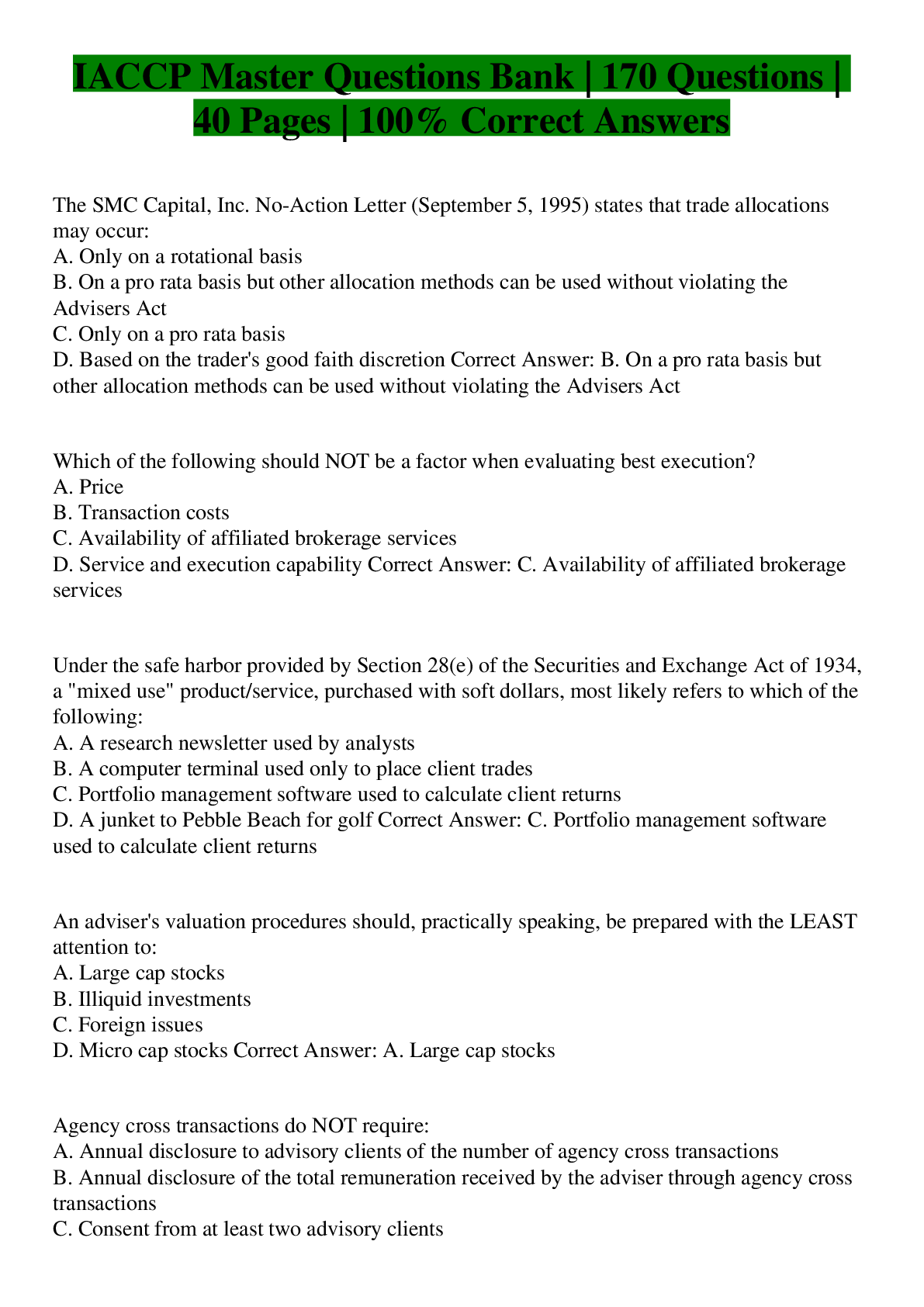
.png)

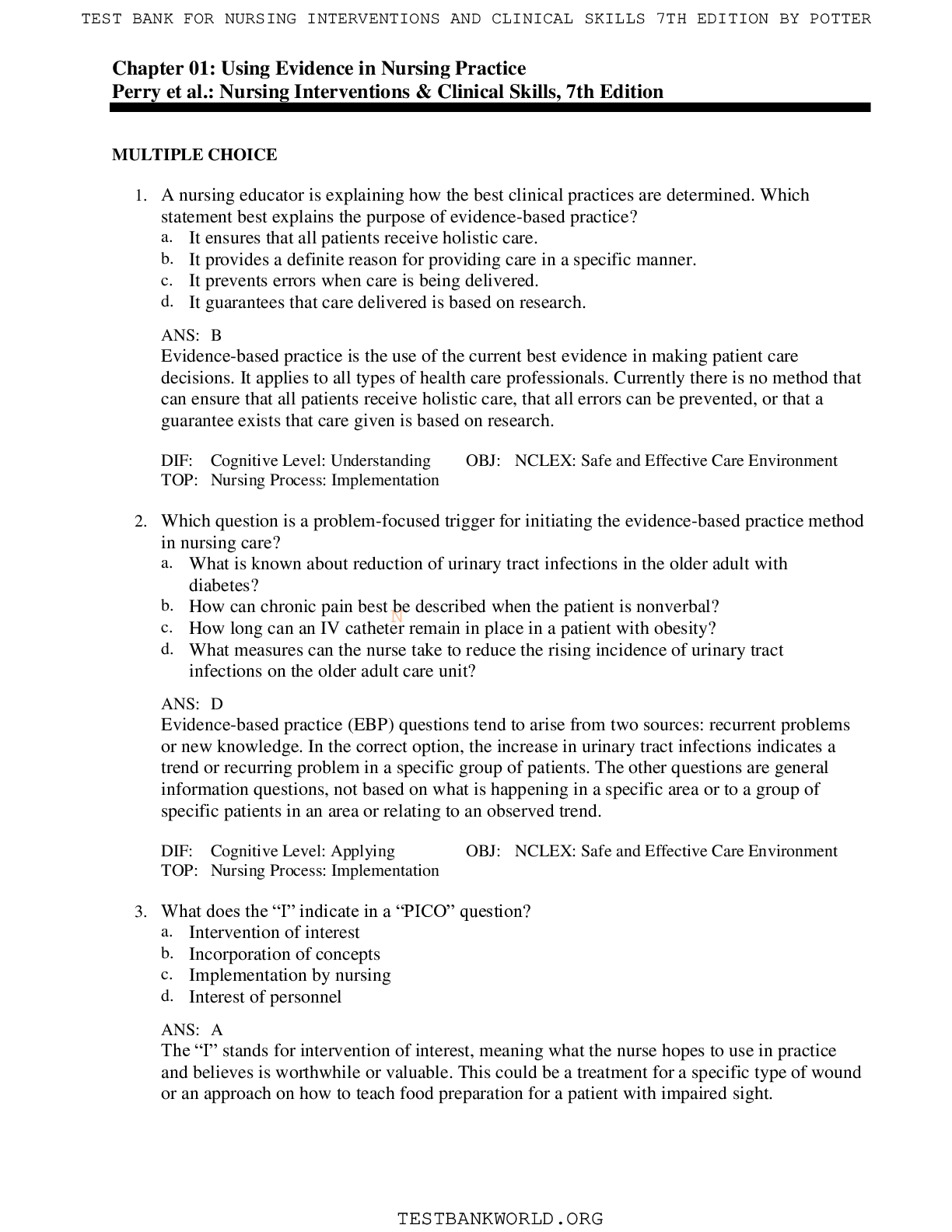

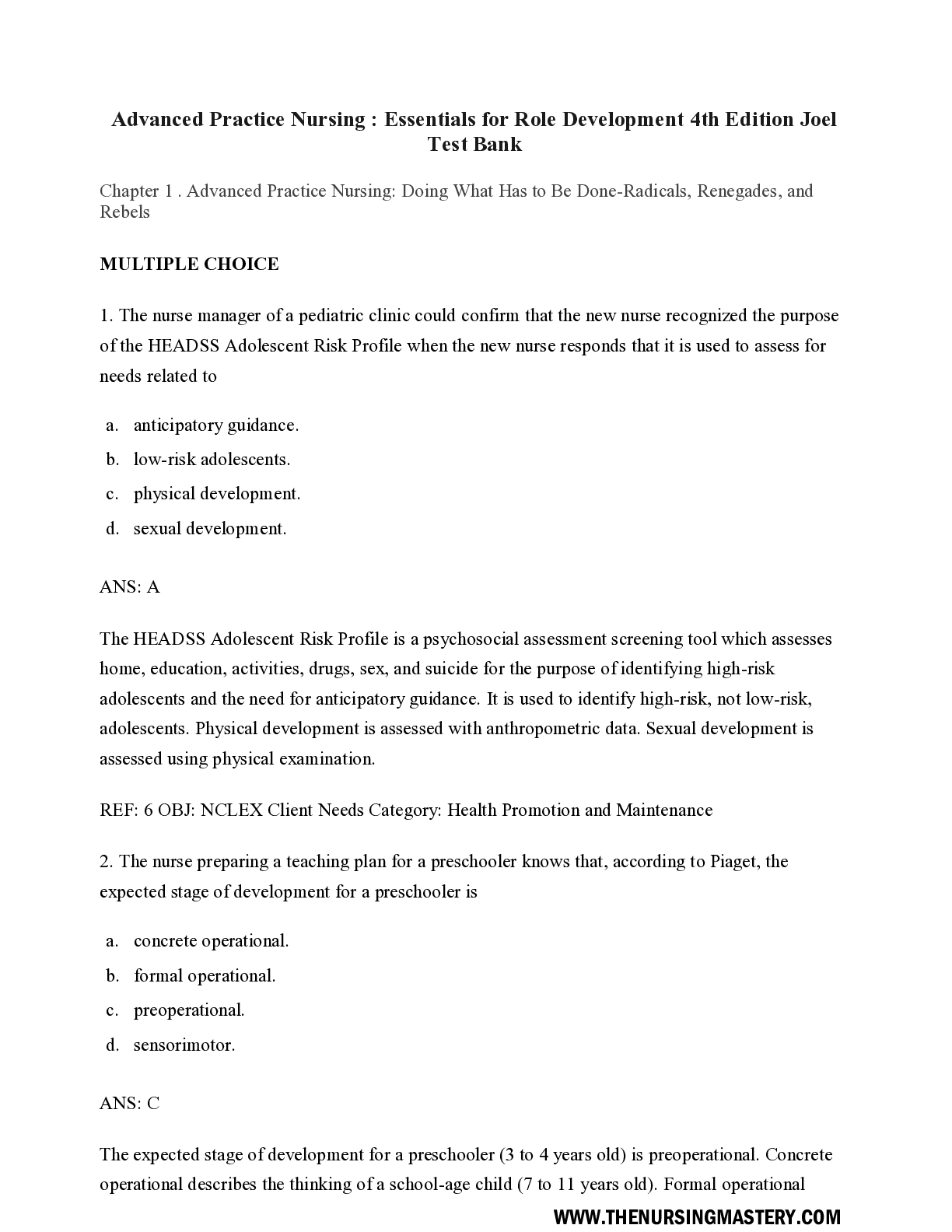
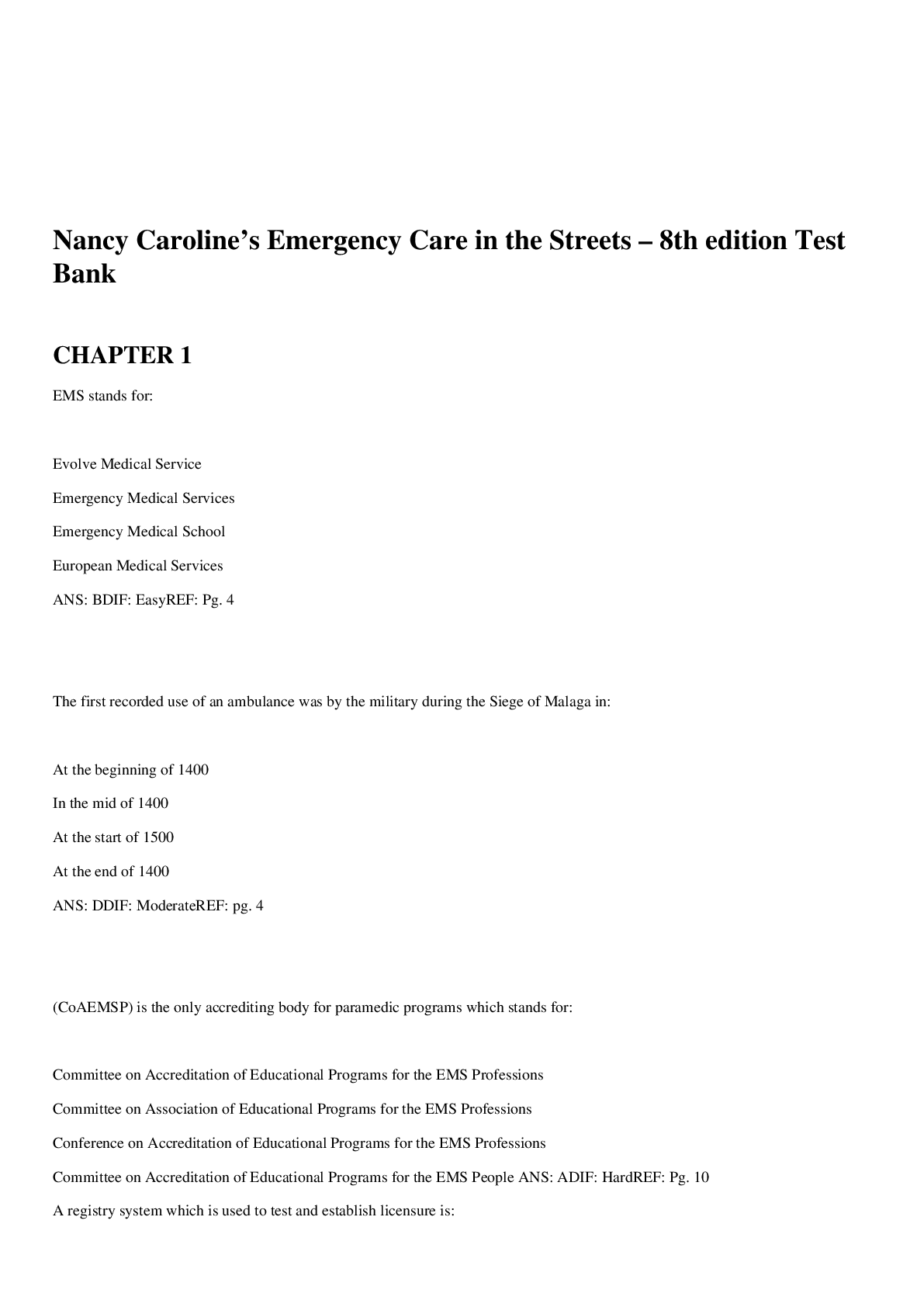


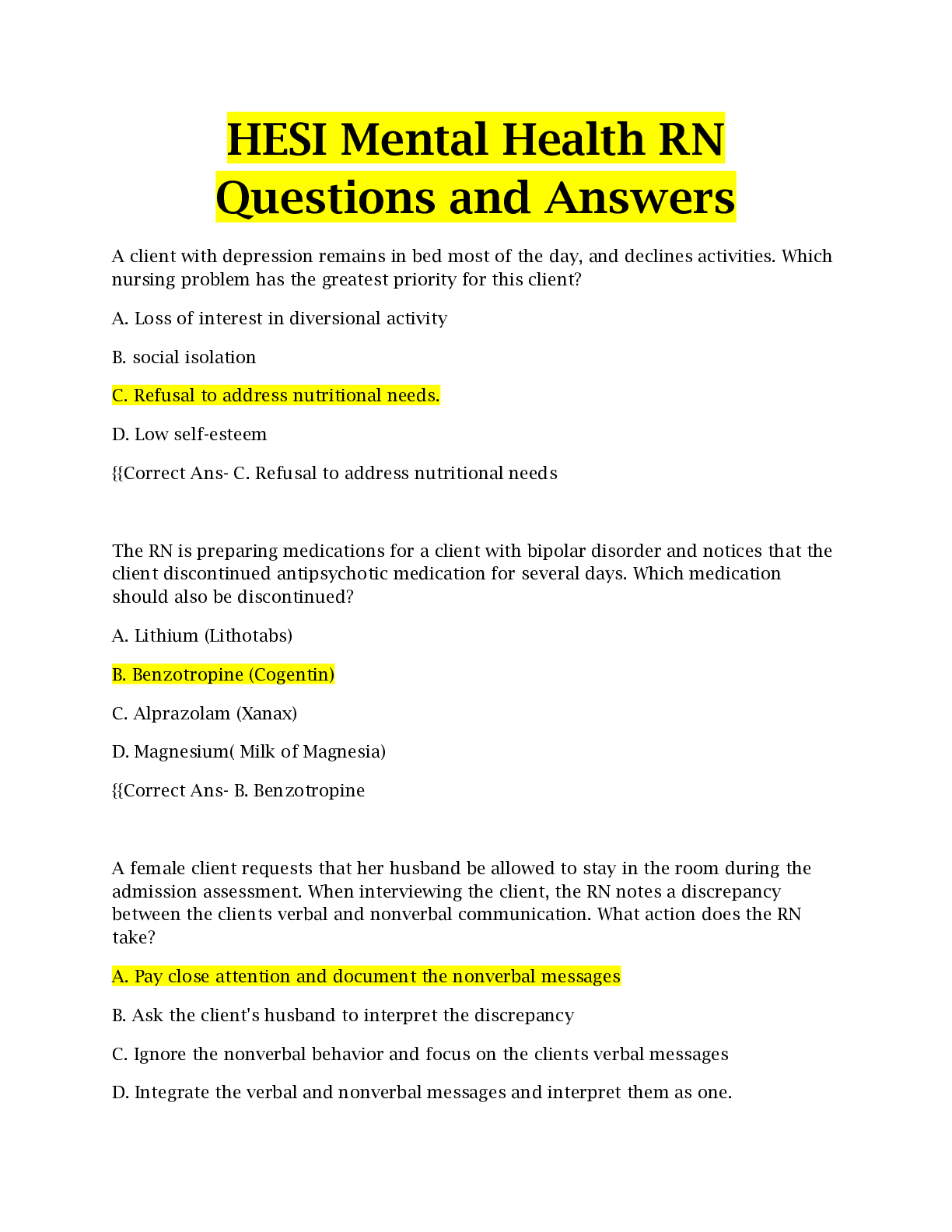
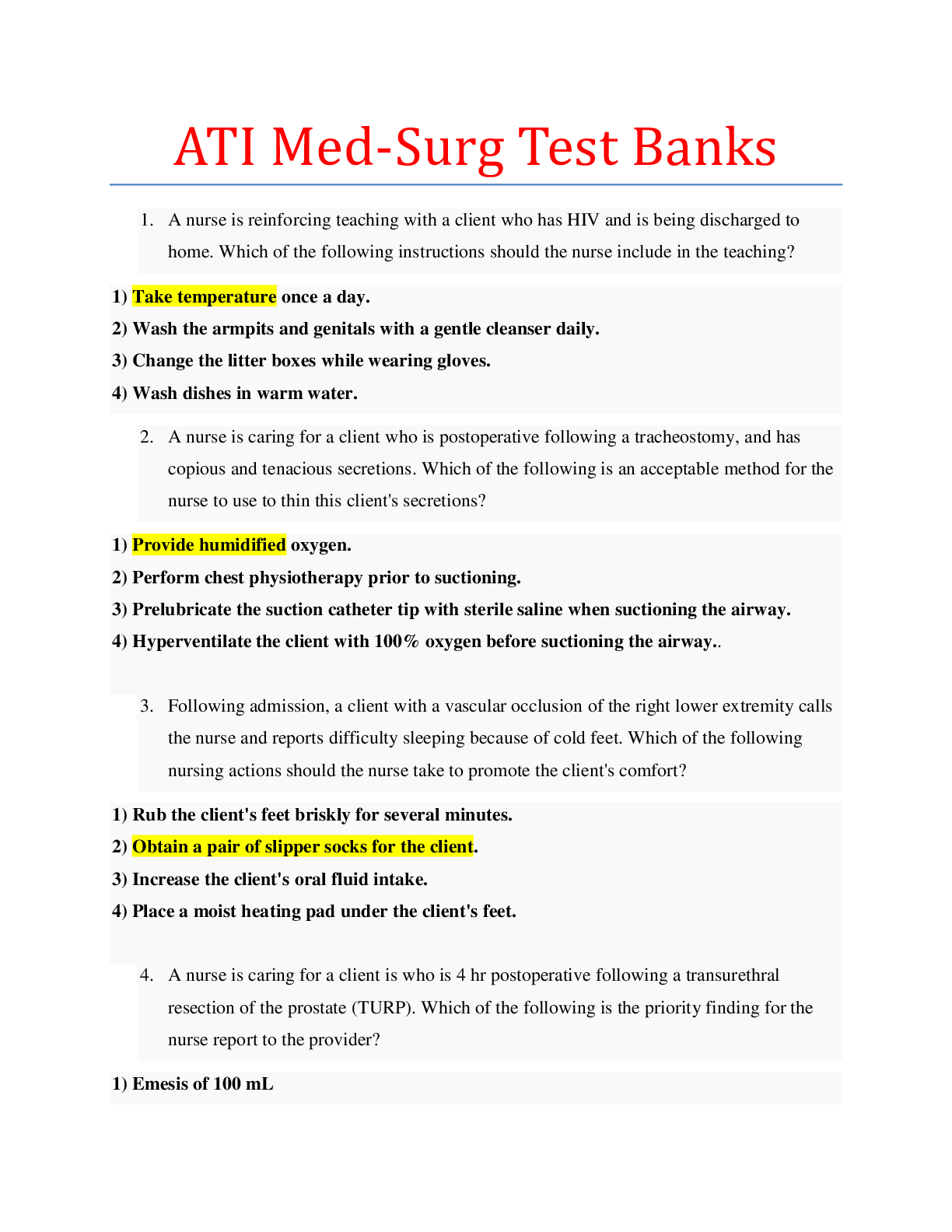
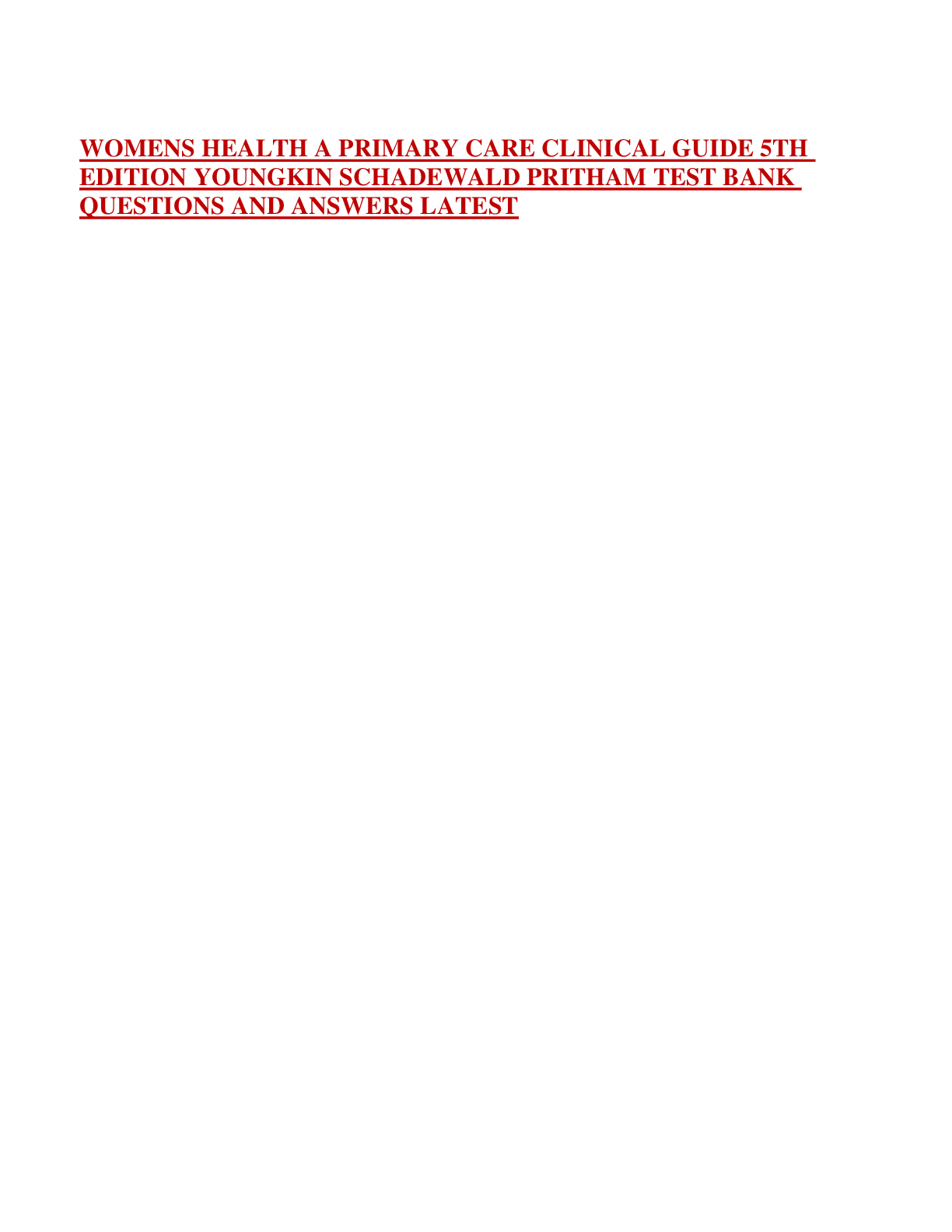
.png)
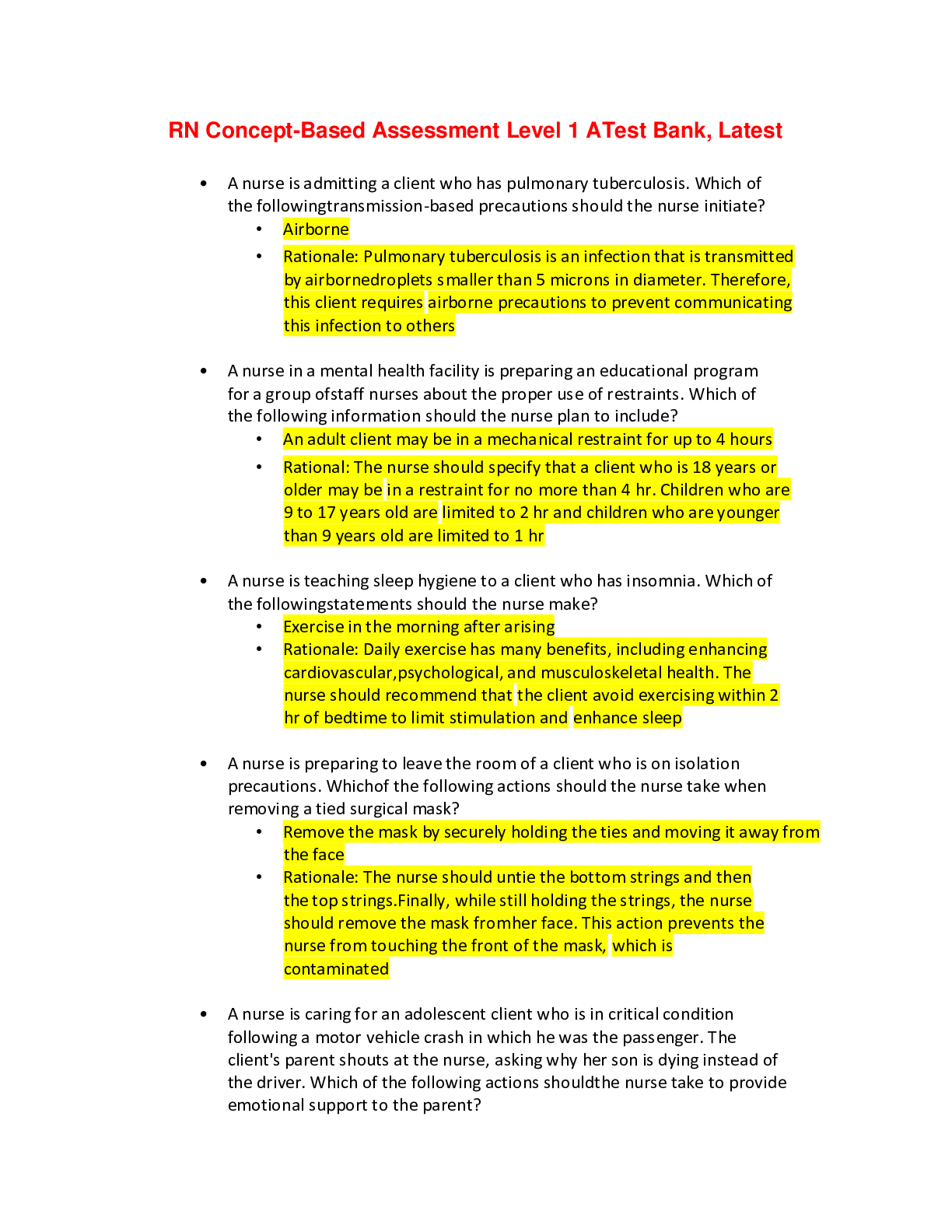
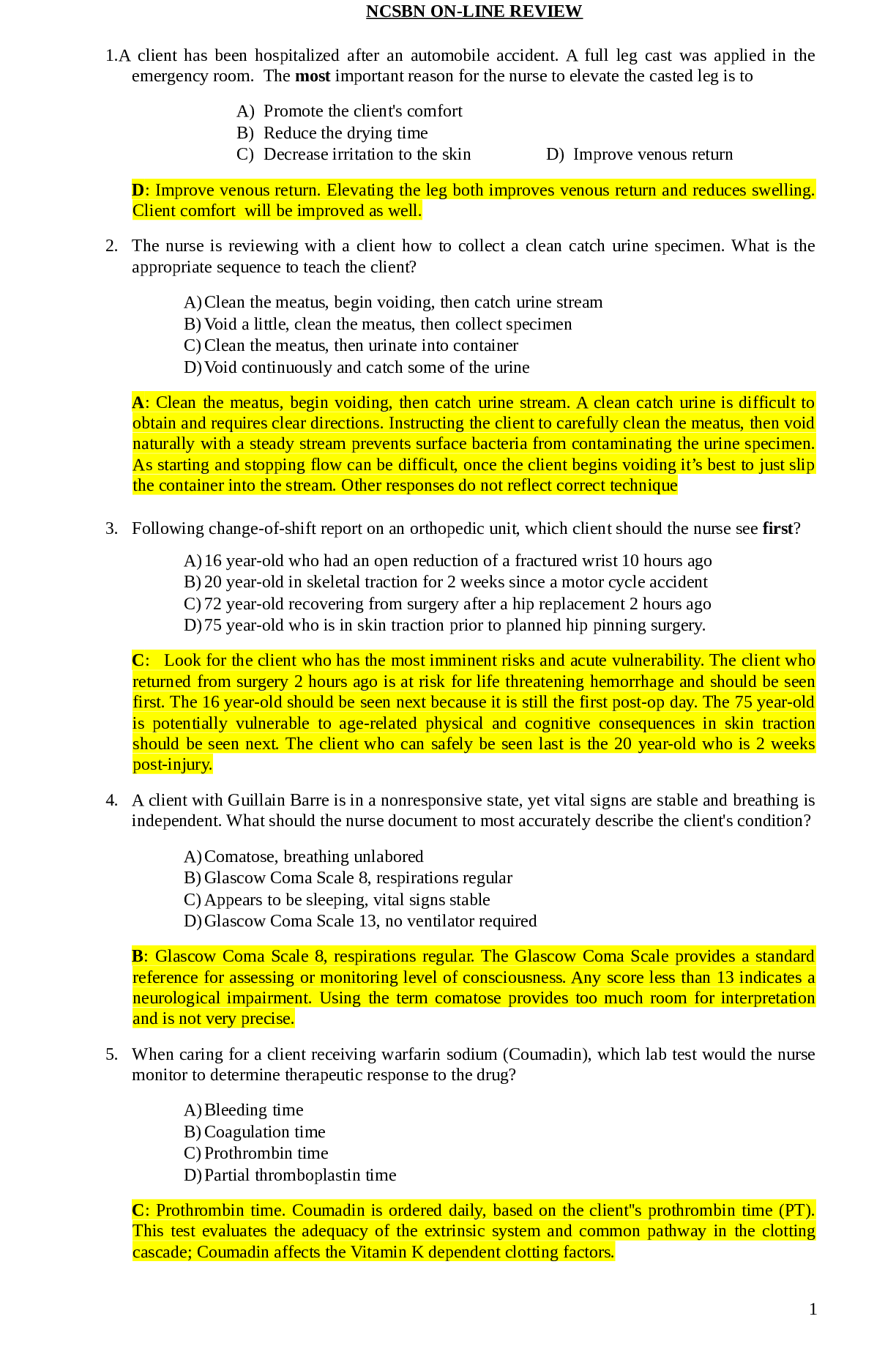

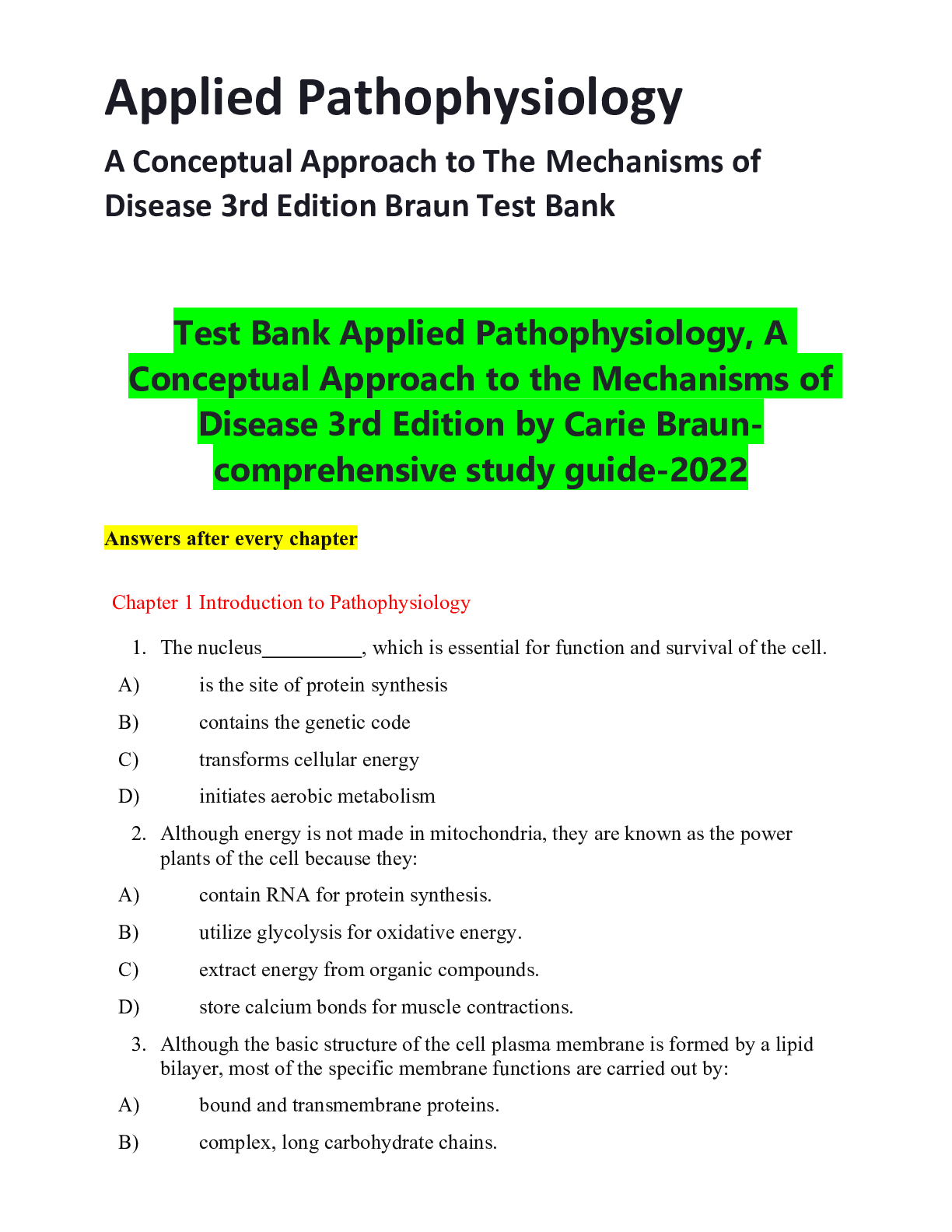
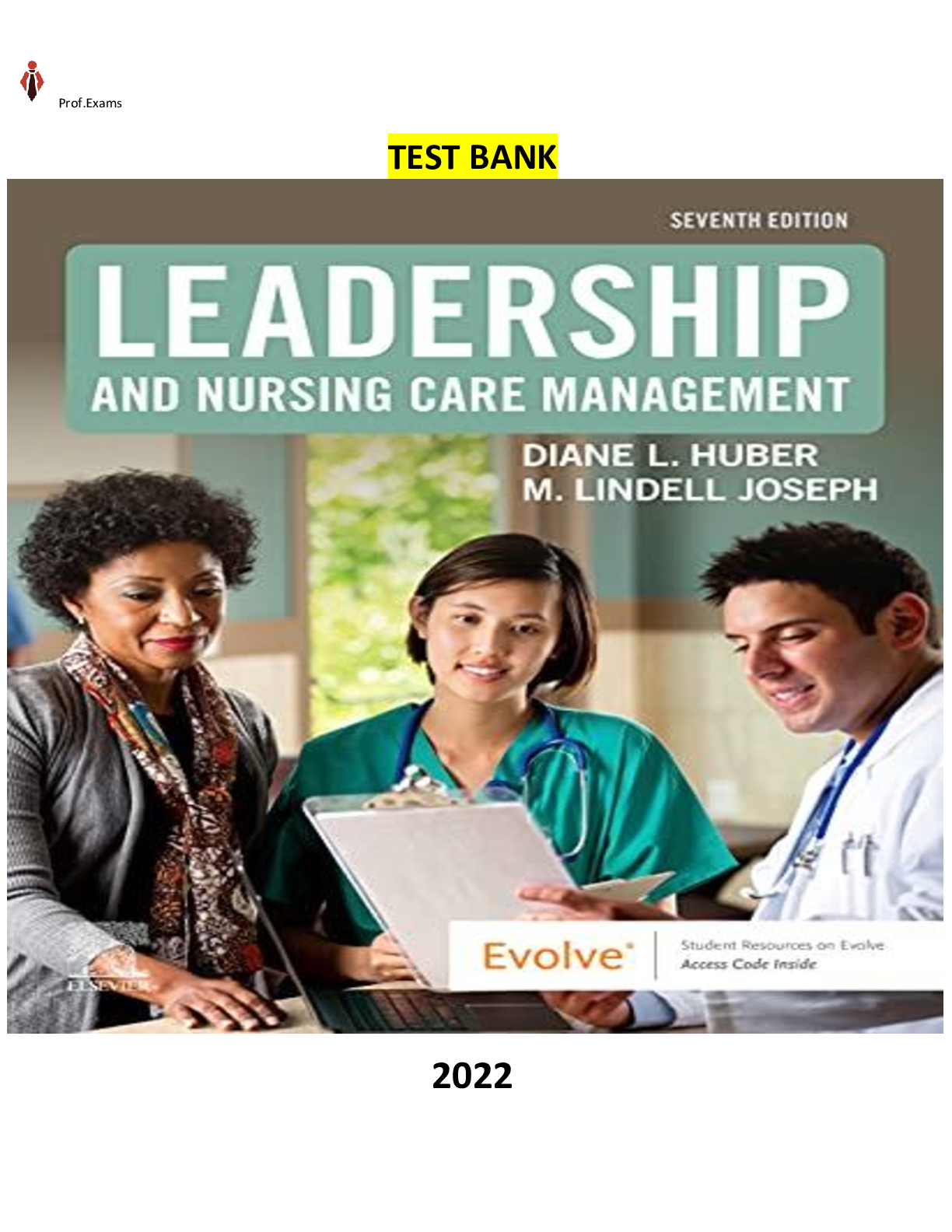
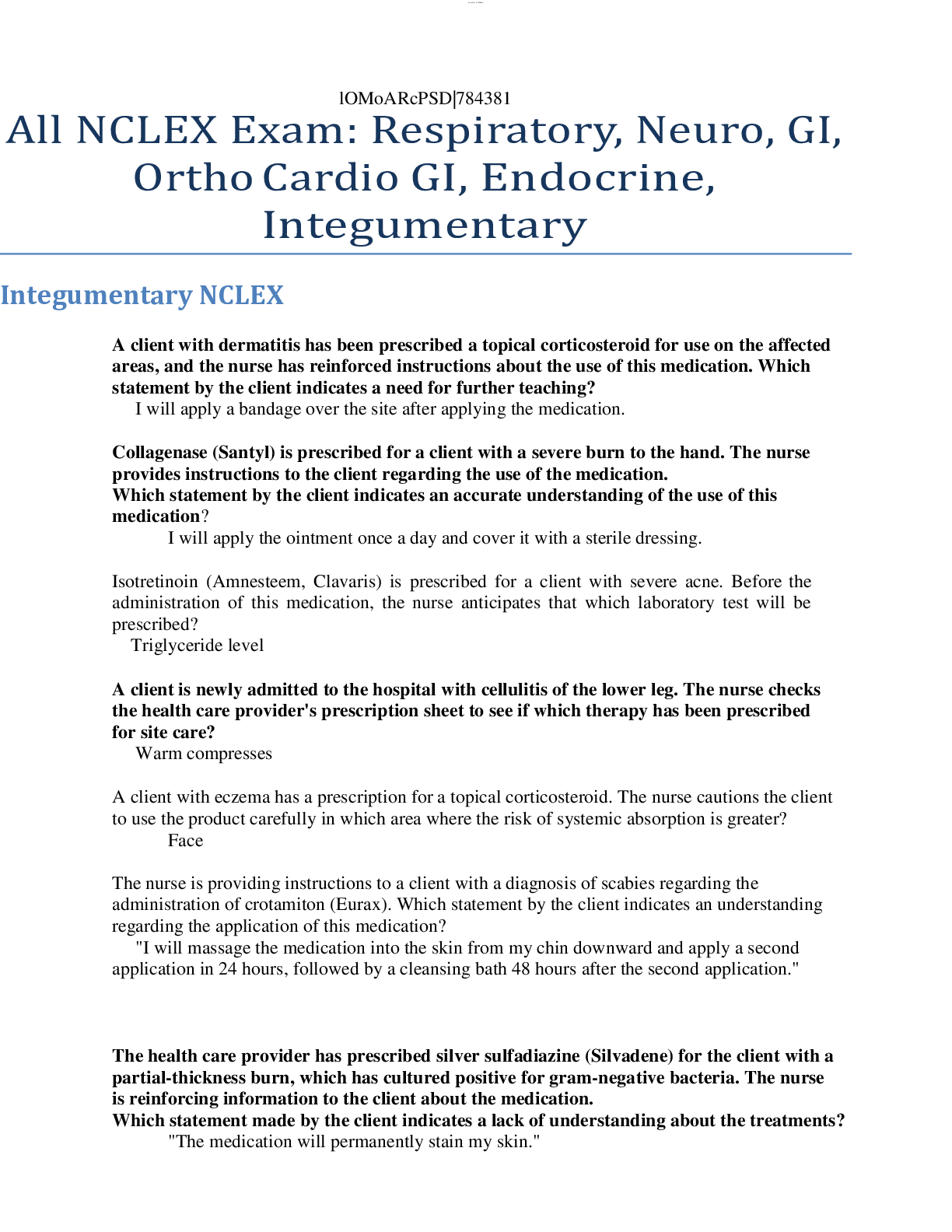
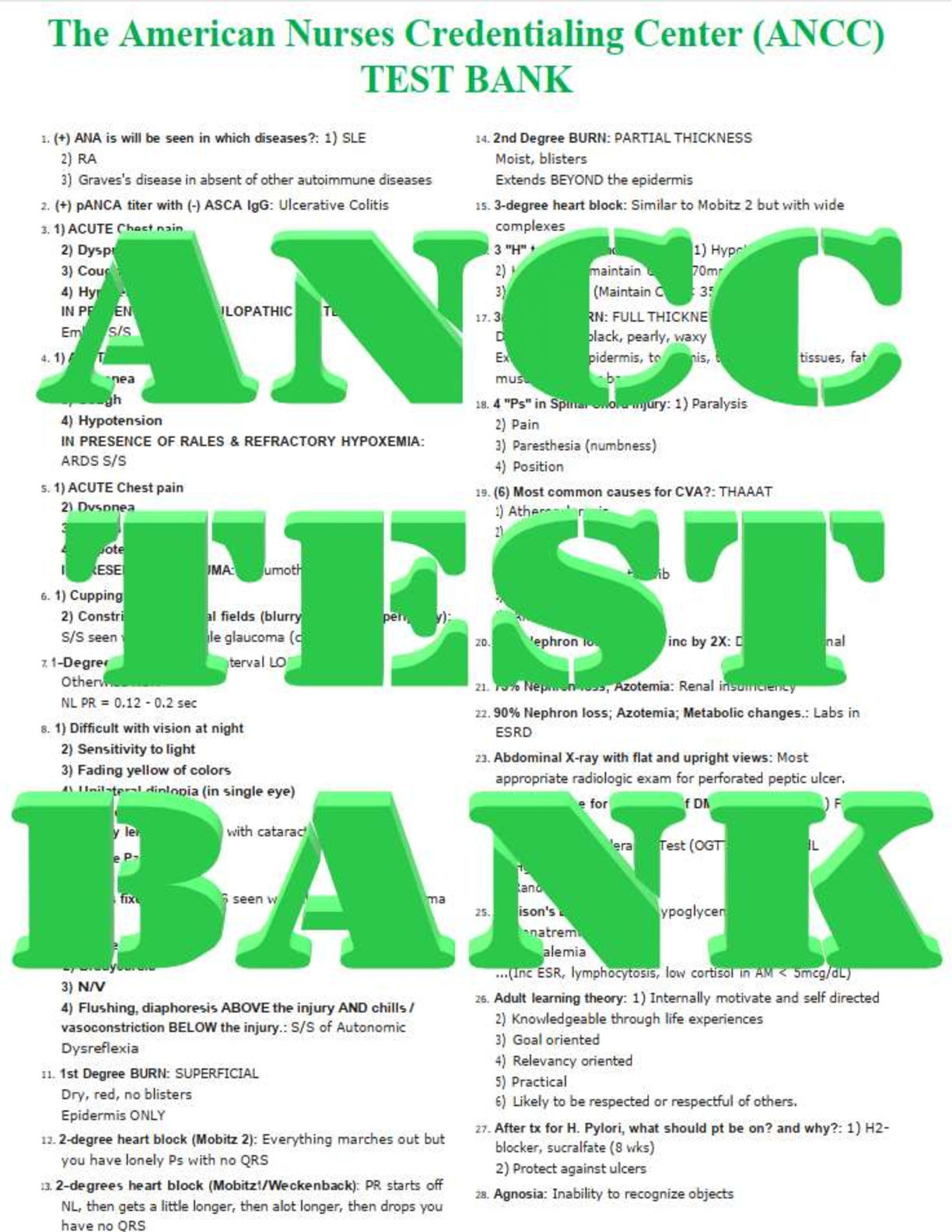
.png)
.png)
